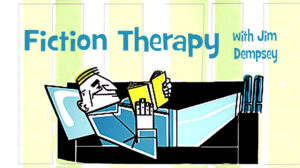Editing
Raise your hand if you’ve ever visited one of those well-known medical “information” websites, only to become convinced within minutes that you have a rare, incurable cancer. (Raises hand.)
There have been times when I’ve wished that there was a WebMD for writers, where I could type in symptoms like “this scene feels slow” or “I don’t know how to ratchet up the stakes” and be offered a list of possible diagnoses, followed by a step-by-step list of cures.
When I struggle to write, it usually feels less like a roadblock and more like a slow wade through a river of molasses. Delicious? Maybe. Good for you? Decidedly not. It feels like the opposite of the flow state, or that feeling of being fully and energetically immersed in the act of writing. Instead, each word starts to feel like a slog, each sentence like I’m painstakingly carving them out of stone.
But I’ve only recently realized that this feeling isn’t something that’s wrong with me, but rather that writing starts feeling agonizing when something isn’t working in the writing itself. Figuring out exactly what that is, of course, is a challenge that depends a lot on the author’s own style and quirks. It’s taken a lot of trial and error to get to where I can recognize the symptoms of “something isn’t working here.”
There are an endless number of reasons that writer’s block (“writer’s river of molasses” just doesn’t flow as well, pun intended) can crop up. This post only deals with one of those reasons: when you know something isn’t working, but you aren’t sure what.
There are a few tests that I’ve landed on as helpful tools for figuring out what that something is. They are geared toward fiction writing, but your tests will probably look different at any rate. While they’re in no particular order, I hope they can at least serve as a starting point.
Take a break.
How is “take a break” a test? Sometimes I look at a scene for so long that I lose the forest for the trees. Sometimes I’m just having a day of brain fog. I’ll take some time away from the story—sometimes just for a few hours, but often for a few days—and when I return, the words come easily.
But when I say “take a break,” I really mean take a break, not “work on something else,” not “write a different scene” or “do research” or “outline the rest of the book.” Stop, entirely, and give your brain a chance to recover. I know our society rewards constant work, but every time I’ve grumpily, reluctantly taken a few steps back from writing, I’ve returned with a clearer head, feeling better about everything. Sometimes I can see clearly what’s not working, and other times I don’t even remember what was bothering me, and other times I can at least think more clearly about what might not be working.
I know I said these tests were in no particular order, but I would recommend trying this one first because sometimes, as the IT team at one of my old jobs used to say, the problem is PICNIC: “problem in chair, not in computer.” If you feel stuck, sometimes what’s wrong is in our […]
Read MoreRuth was reading an old Susan Howatch novel on her Kindle, which tracks the percentage of the book you’ve read without bothering about page numbers. After reading for a few days, she noticed that she hadn’t made much of a dent on the percentage. I asked the internet and found that the paperback of the novel had been more than 1100 pages long.
I’ve always argued that a manuscript should be as long as it needs to be to tell its story. A lot of successful books – Jonathan Livingston Seagull, or The Bridges of Madison County spring to mind – are not much more than novella length. The Lord of the Rings, broken into three books but really a single, continuous story, clocks in at 1086 pages, not including the appendices. None of them feel too short or too long.
Besides, trying to force your story to fit a predetermined page count because you think that’s what the market demands is almost always a recipe for disaster. Adding or cutting material just for the sake of adjusting the length leads to either in gaps in the narrative or padding that drags the story down. This is not to say that all first drafts are the right length out of the gate. Sometimes stories do drag and need trimming to flow better. Others are too thin and need subplots built up or more details on the characters’ internal lives. But these are changes made for the sake of getting the story right, not to fit the market.
So how do you know whether your odd-length manuscript is just what it needs to be or is too bloated or anemic? Successful novella-length novels usually succeed because they are centered around a character development or story point that didn’t need a lot of pages to convey but that carries the emotional weight of a full-length novel. Readers can finish them quickly and not feel underfed.
I’ve written before about Ted Chiang’s “Story of Your Life,” the novella on which the movie “Arrival” was based. In the story, Chiang gives a sense of what it would feel like to experience time all at once rather than in linear sequence – and only reveals that that’s what he’s doing at the end of the story. That’s enough masterful storytelling for a novel, but adding more material would have distracted from the central point. It is a short book that still feels like a long book.
Extremely long novels also have a couple of features that make readers willing to put up with four-digit page counts. The Lord of the Rings creates a complex world with several independent cultures and thousands of years of backstory. It takes time to get all that across. The same is true of massive, multigenerational works, like the Susan Howatch book Ruth was reading.
Long novels often work two or more different complex threads at once – effectively telling a single story through several different, interwoven novels. After The Fellowship of the Ring, Tolkien’s narrative splits up into at least three threads – Frodo, Sam, and Gollum making their way into Mordor, Pippin and Merry rousing the Ents, and Aragorn heading down to defend Gondor. These threads cross occasionally and come […]
Read MoreI wasn’t able to submit my regular monthly article in June. And I felt so bad about it because I only gave the Writer Unboxed team a couple of days notice that I wouldn’t fulfill my commitment. Of course, everyone at WU is extremely supportive, and I even gained some sympathy when I gave the reason why: I had just moved house.
I had totally underestimated what this would involve, despite having moved house many times in my life. Moving to a new house is regularly in the top five most stressful life events – often placed higher than a major illness and losing your job.
There’s a lot involved in moving house. There’s all the packing, and we shouldn’t forget the emotional aspect to that, of finding something tucked away in a drawer that reminds you of an earlier time or a loved one. You might be moving farther from your friends and have to go through the whole process of meeting new people. Maybe the children have to start a new school, and they probably won’t want to, so you have all the stress of upset kids. Then there are the practical things like changing address at so many different agencies, companies and organizations. Plus the physical labor involved in lugging boxes around and shifting furniture.
And that’s just a few of the things you have to deal with. I’ve just gone through the process and already I find it difficult to list everything involved. That’s what makes it so easy to underestimate – there’s just so much involved.
As our wonderful and understanding WU editor, Therese, told me, “Moving is such a huge undertaking, and it’s the ‘gift’ that keeps on taking time, energy and usually $$.”
Thankfully, writing is much easier. As Hemingway said, “All you do is sit down at a typewriter and bleed.”
Yep, not easy either.
To procrastinate or not
Novels usually start with an idea, and that’s often the easiest part of the process. Inspiration can come in a flash. Or you get that spark which smolders for a while until you get the burning need get the whole story down on the page.
That’s where the procrastination starts.
Do you just start up your computer and get tapping away with your standard word processing program or do you go for a more specialized software, like Scrivener? There’s no right or wrong answer to that, more a personal preference. The main thing is to get writing. And that’s not just about procrastination, there are some serious decision to be taken then.
One of the most important choices an author has to make is: who is going to narrate the story. Will you give readers an omniscient god-like point of view, looking down on your characters as if from above, seeing them all move around and interact. This is great for sprawling epics or stories with many characters because it gives readers an overview of the drama and it’s easier to switch from one character to another. Da Vinci Code by Dan Brown is an example of this. The disadvantage is that an omniscient perspective can feel distant, detached from the characters.
To get nearer to your protagonist, you might want to chose a close third-person perspective. In this case readers get the direct thoughts […]
Read MoreCredit: NASA/JPL-Caltech
It’s hard enough to create a single fictional world, one that’s internally consistent, gives your readers enough details to feel they’re actually there, and gives a dramatic background for your story. This is why, when you’re creating a world different from the one we all share – in historical novels, fantasies, science fiction – you tend to only create the one world.
Thing is, what your world is like depends on who’s looking at it. All of us filter what we see through our own experiences and prejudices. We assume some things are true and tend to see them whether they’re there or not. The world of someone who’s survived childhood abuse is a much scarier place than most of us know. So the way to create a fictional world is to get so deeply into your main character’s head that you make your readers see the world as they see it. As I say, it’s hard enough to do once.
What if you could do it several times?
Many years ago – long enough that I’ve forgotten the author’s name — I edited a manuscript about a land dispute on a Navajo reservation – a sacred site was going to be developed, and people were upset about it. The story started out with a scene from inside the head of an old Navajo woman whose grandfather had settled the land. She was up against Bureau of Indian Affairs lawyer and the Hopi Sheriff who was helping him. Through her eyes, readers saw the Sheriff as a sellout and the BIA lawyer as a burned-out bureaucrat who didn’t care about the people he was supposed to be helping.
The next scene was from the point of view of the Hopi Sheriff, whose grandfather had lived on the land until the Navajo woman’s grandfather had taken it away from him. He saw her as a self-righteous troublemaker who didn’t know the history of her own people. He also saw the BIA lawyer as a cynical bureaucrat.
Then you got into the BIA lawyer’s head and found out that he joined the Bureau because he wanted to do some good in the world. But he didn’t have the budget or the resources he needed, and found that both sides of the dispute he was trying to negotiate hated him. And so it went. Every new character whose head you entered had a distinct take on the same situation.
So why would you want to put in the effort of changing your readers’ perceptions with every new point of view?
It can make for better drama, for one thing. You can draw readers into your story with a conflict where one person’s right and the other is wrong. But where both sides have a point, the drama moves to a deeper level. Readers aren’t simply worried about who will win. They’re worried about who they want to win.
You can also work conflict into your story by putting two worlds on collision course.
Elizabeth Cadell’s The Fledgling tells the story of Tory, a young girl, raised by aged maiden aunts in Portugal, who is going to a boarding school in England. Her father has arranged for a chaperone, Mr. Darlan, for the train trip. […]
Read MoreAs a novelist, all the book ideas I’ve ever contemplated hinge on an element of climate crisis, not by choice, but because these stories rise up as manifestations of my own climate anxiety. Stories about our global environmental emergency are simultaneously existential and minute.
They are urgent.
I would use the same words to describe The World as We Knew It: Dispatches from a Changing Climate (Catapult), a new anthology of personal essays about the impacts of climate change on the essayists’ lives edited by Amy Brady and Tajja Isen. Stories about drought in Arizona. Invasive species that change ecosystems. Nostalgia for absent fireflies. Hurricane Katrina.
This book is urgent.
But what makes this collection stand out among other anthologies addressing the climate crisis is the sense of urgency coupled with intimacy. The quality of the storytelling elevates the content in ways that inspire me as a fiction writer.
The all-star list of contributors includes some of the most compelling climate communicators of our time, both in fiction and nonfiction, including climate justice essayist Mary Annaïse Heglar, one of my favorite voices communicating about the climate crisis. In her voice, the complicated feels personal, terrifying, tender, and memorable. She contributed an essay called After the Storm about her family’s experience during and after Hurricane Katrina which will stay with me for a long time.
Novelist Omar El Akkad (American War and What Strange Paradise) contributed an essay about the devastating consequences of climate change and development in Qatar where he grew up, and his concern not only for our future but for our ability to preserve the past. Stories layered in stories. Urgent.
I read The World as We Knew It as a concerned citizen of this fragile planet and as a reader who appreciates powerful writing, but I also read the essays to study the architecture of compelling storytelling.
I read a lot of books on the craft of writing fiction. I subscribe to a long list of writerly newsletters and podcasts. Although The World as We Knew It is a collection of essays, not a book about writing, I’m shelving it with my books on the craft of writing because as I embark on writing my third novel, I anticipate returning to these essays many times as reminders of the power of urgent, intimate storytelling.
I reached out to the editors, Dr. Amy Brady, the Executive Director of Orion and the former Editor-in-Chief of the Chicago Review of Books, and Tajja Isen, the author of Some of My Best Friends: Essays on Lip Service and an editor for Catapult Magazine. They responded to my questions together, so their answers are in the ‘we’ form.
Julie Carrick Dalton: How did you choose the writers to include in your anthology?
Amy Brady and Tajja Isen: We collaborated on an initial dream list and were bowled over when most of the writers we contacted said yes! It was a mix of folks who had already published on climate, and those whose work we loved but hadn’t explicitly published in that space before. Their contributions, we felt, offered an exciting opportunity to expand what “climate writing” looks like, connecting the dots between the climate crisis and other narratives both global and personal.
JCD: Who is your intended audience?
AB […]
Photo Stinjn Sinnen
Tension is the propulsive force of story—the means by which the storyteller not only spins her thread, but then holds it taut and pulls her reader steadily through the tale. Let that tension drop and the thread collapses, momentum stops, and readers put down your book.
Without tension, all you have is a pretty pile of yarn.
It sounds like a tall order—or a recipe for melodrama—but as the force that gives structure and form to the web you’re weaving, tension belongs in every single thread of your story.
Harnessing its power to pull readers into your web without risking sensationalism or soap opera involves expanding our definition of what tension is and how to incorporate it.
Tension is often defined or understood to be basically some form of opposition, friction, conflict, an obstacle. But perhaps a better way to think of it in weaving it throughout your story is that tension is anything contrary to a character’s (and reader’s) desires or expectations, however minor.
Tension Isn’t Always Obvious
Tension doesn’t always mean high drama, high conflict, or even high stakes. It can be overt and direct—an argument, a slap in the face, the killer at the door. But weaving it throughout your story often involves much subtler, indirect tension, what’s sometimes referred to as “microtension.”
Tension can be a million little moments in every scene—even the seemingly light, happy ones. Smooth sailing may be a #lifegoal, but it’s a storytelling death knell.
Conflict may briefly relax for those “upswing” moments of your story, scenes of connection and progress and triumph, but even in your story’s high points, some form of tension should be lurking:
So how do you use this powerful force to weave the tapestry of your story tightly?
Use Opposition to Create Tension
Let’s dissect a snippet from the opening pages of Steven Rowley’s delightfully humorous, poignant novel The Guncle, where the only thing at stake ostensibly is two children—staying temporarily with their single gay uncle after the death of their mom—wanting to make a YouTube video.
Patrick hovered his finger over his phone before calmly hitting record. “Tell me something about your mother.”
Maisie and Grant turned inward, each willing the other to speak. Patrick had never witnessed such a case of debilitating stage fright in his entire career. […]
Read MoreWith permission from Alan Levine, pxhere.com
Recently, I allowed myself to type those two precious words:
THE END
I’d completed my first rough draft of my historical novel-in-progress. Of course, finishing a draft is not THE END at all.
Those two magical words are the call to arms, the rallying cry to get one’s butt back into one’s damned chair, to double down, dig deep, grovel, beg, and maybe ugly cry.
It’s time to revise.
Hopefully, one is armed with tissues as well as a stash of tried-and-true methods for honing, pruning, enriching and revealing; plus the fresh input of trusted beta readers, freelance editors, a publishing editor, and/or literary agent (if one’s agent is the editorial sort).
I asked four generous and highly esteemed fellow authors whose names begin with “J” about their tips-n-tricks for revision so that I can, selfishly, mine their ideas for my own use. And yes, I am sharing the 411 here with you.
Janet Fitch- author of the Oprah’s Book Club selection and feature film, WHITE OLEANDER; and most recently, CHIMES OF A LOST CATHEDRAL. Her Janet Fitch’s Writing Wednesday YouTube series is a gem.
“I think in terms of revision “layers”. First layer, the scenes—making sure each scene has a change, that something has good and truly happened, and the POV character can’t go back to the way it was before. Second layer, I check the senses—am I embodying the story, using all the senses, every page? I make sure the WHERE is firmly established and continues to be refreshed. Third layer, the polishing. I make sure every sentence sings—checking the verbs for specificity and flavor, that the language has texture or ‘crunch,’ and that there’s variety in sentence length and structure. I will read this draft aloud, listening for the music I’m making.”
Jane Healey- bestselling historical novelist and host of the fab webinar series H3- Historical Happy Hour. Her most recent book, THE SECRET STEALERS is out from Lake Union Publishing.
“When I’m revising I always remind myself that readers are very smart, so in the first round of revisions, I do what I think of as a “macro” review and question every chapter, every scene and every event and ask myself, does this chapter/scene/event matter enough to remain in the story? Does it advance the narrative or shed light on character enough that it deserves to stay in the novel? And if it doesn’t, I take it out (always saving it somewhere else just in case). And then the next round is the micro review – more of a line by line review of exposition, dialogue etc. to make sure that I’m not talking down to readers in any way – I’m not repeating things they already know, or annoying them with details they don’t need to know. I find reading out loud helps at this stage, it’s much easier to spot clunky dialogue or unnecessary description when I read out loud.”
Jacquelyn Mitchard- #1 New York Times Bestselling novelist (and a former MFA advisor of mine), whose latest, Read More
Over the last few years, I’ve come to seriously admire authors who write well-crafted, efficient sentences. I’m thinking of sentences that aren’t necessarily simple or grammatically perfect, but rather ones in which each word seems carefully chosen to pack the biggest punch. Take, for example, the first line from Delia Owens’s Where the Crawdads Sing:
The morning burned so August-hot, the marsh’s moist breath hung the oaks and pines with fog.
Look at that sentence! Not a single word is wasted. Each one carries weight, fully embodying its own essence, coming together to form a backdrop you can feel on your skin in just sixteen words.
I think of sentences like these as IKEA storage units. Not a very romantic descriptor, I know, but bear with me: these sentences are make efficient, attractive use of limited space for maximum impact.
This type of writing is a matter of personal taste, not correctness. But if you, like me, tend to veer toward the verbose rather than the succinct, toward the Faulknerian rather than the Hemingwayan—and, most critically, you want to tone it down a notch or two—it’s surprisingly easy to build a self-editing habit into your writing practice.
Writing as Interior Design: Endless Metaphors Ahoy
If I were to describe my natural writing style in terms of interior décor, the words “eclectic” and “maximalism” come to mind. A less polite but more accurate phrase would be “a hot mess.”
I could spend hours wandering around an IKEA display floor. Unfortunately for me, translating my admiration of smart storage to my own home is more difficult. I’ve always wished that I could be one of those people to whom interior decorating and organization comes naturally. But as I am not, I recognize that that decorating my own home is going to take a lot more planning and forethought than for someone with a knack for design. As much as I may want to, I can’t just wander into a flea market and wander out with an armful of knickknacks that will look effortlessly put-together.
This, of course, assumes that I want my space to look effortlessly put-together. There are plenty of people who couldn’t care one way or the other what their “aesthetic” is, which is completely valid, and others for whom a mismatched eclectic is their aesthetic, which is also completely valid. Unfortunately, I like the IKEA aesthetic, yet have none of the inherent talent to replicate it.
[Extremely Barack Obama voice:] Now, let me be clear.
You know by now that I’m comparing interior décor styles to writing. But I am emphatically not suggesting that everyone should write like Hemingway, nor that simple sentences are inherently good writing. I am an absolute sucker for some lyrical prose, some wandering sentences, some poetic repetition and other literary devices. Just as the world would be boring if every house was Scandinavian minimalist, the world would also be boring if every sentence is always perfectly efficient.
That said, being prudent with words can be a useful skill to have in one’s back pocket, whether for professional purposes, to draw attention to a particularly intense scene, or just because you want to spice up your writing style a little. And despite being a chronic over-writer by nature, I’ve managed to turn concision […]
Read MoreLast month, I wrote about how hard it is to write morally good characters. In the comments, it came up that writing evil characters can be just as hard, though for different reasons.
Evil characters can be easy to write because they’re often more clearly aware of their intentions than good ones. But to write believable evil characters, you have to get inside their minds. Anyone who gives advice on writing will tell you that you have to humanize your bad guys for them to be effective — cartoon evil is no more interesting than cartoon good. But writers also need a warning about just how painful it can be to enter an evil mind.
A lot of writers try to dodge the question by just giving their villains the standard abusive childhood – as if no bad guy ever came from a happy home. Some avoid ever writing from their villain’s point of view, keeping their evil at a distance. But to really make an evil character effective and memorable, you need to enter their worldview and see life as they see it.
Many evil people don’t think of themselves as evil. So one way to get into the minds of some villains is to try to see why they feel that what they are doing is good. They’re hurting people and destroying lives, but it’s for the greater good. They might have to commit murder, but it’s to save even more people. This sense of their own righteousness doesn’t necessarily excuse their actions – it could be massive self-delusion. But it does give you a way to get into the head of someone actively causing pain. To paraphrase C. S. Lewis, people who hurt you for their own pleasure are far less dangerous than people who hurt you for your own good.
Some evil characters know that what they’re doing is evil, but they didn’t set out to do it. They simply started with some minor, easily excused infraction that just snowballs. An embezzler lifts a few thousand dollars from a work account to cover a debt, then has to falsify tax records when it isn’t paid back in time. And then has to throw blame on a co-worker and perhaps embezzle more to escape, or even kill the auditor who discovered the grift. Again, this is not an excuse – at any point in the sequence, the villain could have bowed out. But following a character through a series of bad decisions, each one building on the last, each one harder to justify, can actually be a good source of tension.
Some people are, though, simply evil, and those heads are the hardest to get into. Seeing the world from inside the head of someone who delights in destruction can only be done if you put aside your own humanity. It can be wrenching and exhausting. It doesn’t matter. Do it anyway. Just give yourself to it.
There is certainly room in the world for light, gentle, hopeful books. But to write books that show readers a harsher, grittier reality often means you have to stare evil squarely in the face, understand it, even accept it at some level. Many writers don’t have the courage. I often […]
Read MoreAt the start of any mystery or whodunit, often authors find themselves grappling with a conundrum: how, exactly, do I hide my villain or “bad guy” in plain sight? This individual is often a key player in the story, meaning we need to introduce the reader to our villain early (ultimately, this makes for a more satisfying ending: no one wants to learn that the villain is a minor side character who shows up in act III.)
We also need the reader to engage regularly with the hidden villain throughout the story. When keeping our villain’s identity under wraps, we want the reader to not only understand this key character’s motives, but even root for them. And of course, we want the reader to trust the hidden villain.
Below are eight characterization and plot strategies to keep your villain’s identity disguised until that perfect moment when you, the author, decide to unveil the truth.
Use first-person point of view
First-person POV is the easiest way to establish a meaningful connection between your villain and your reader. It allows the reader to effortlessly step into the villain’s emotional state, which is important as we work to establish sympathy for the “bad guy” we’re hoping to hide among our cast of characters.
Personally, I’m a fan of epistolary narrative structures, and this is easily paired with first-person POV. For example, I can think of nothing more compelling than the tell-all diary of a meek and likable villain, documenting (firsthand!) the events leading up to the central crime in a story—a crime they commit.
Provide a sympathetic background
Every character enters a story with his or her own flaws and emotional wounds. Consider making these as relatable, and heart-breaking, as possible. A few ideas: poverty or financial struggles; flawed physical appearance or physical afflictions; or a deep personal loss.
Once you’ve established the emotional or physical characteristics that will make your reader pity your hidden villain, let us into the villain’s thoughts about these characteristics. Show us his or her embarrassment, shame, or grief. Remember, we want the reader to desire healing, and happiness, for the hidden villain.
Establish motivations and goals
Like other key characters in your story, your hidden villain must have his or her own story goals that are both (1) stated out loud, and (2) warranted. We want the reader rooting for the hidden villain throughout the story, and the only way to do this is to establish what, exactly, your bad guy wants—and why.
Once you’ve done this, then…
Throw a wrench in your hidden villain’s plans
Once you’ve established a reader’s sympathy for this all-important character, and once you’ve established that character’s goals, make something bad happen to them. Ideally, this negative event is related to the flaws and emotional wounds you’ve established above. We want the reader to quite literally feel bad for the villain. We want them to say, “aww” or, “oh no…” We want the reader to be convinced that your hidden villain’s goals are out of reach.
This strategy is most effective in acts I and II of your story (because in act III, you’ll be focused on revealing the villain and, hopefully, showing the reader how very wrong they were about this character all along.)
Demonstrate virtue and show emotion
As your villain responds to […]
Read MoreAs I was working on this article, news came of Russia’s deliberate bombing of a train station full of refugees, mostly women and children, trying to escape the shelling in eastern Ukraine. That vile act added some urgency to the topic I was writing about – the problem that evil is often easier to write than goodness.
Evil people make the deliberate decision to be bad and often take delight in doing harm. Goodness is less self-conscious, almost by definition. A lot of good people never think of themselves as good – they don’t let their left hand know what their right hand is doing. In fact, good people are often good because they have doubts or fears and do the right thing in spite of them. Evil is simple. Good is complex. Complex is harder to write.
What makes it even harder is that, to write goodness effectively, you have to be a good person yourself – to face your own doubts or fears and yet have the internal drive to do the generous, self-sacrificing, loving thing. A lot of more ordinary writers, faced with writing good people, fall back on a less challenging alternative. Writing about faith.
While working on a recent client’s memoir, I noticed something odd. When he was writing about his psychological struggles or talking about a tough childhood, he was moving and personal. When he switched to talking about his beliefs and practices, suddenly he was all shallow platitudes. To be fair, his faith may have been as real as the rest of his life, but that’s not how it came across.
Ideally, faith and goodness should be related. Sadly, that’s not always the case. And religious practice offers writers a ready-made language to signal goodness without exploring it.
For most people, beliefs are shaped and supported by an often tight-knit faith community. Like any other relatively closed group, these communities tend to develop their own shorthand for talking about complex, familiar concepts. For those who simply want to create a sense of goodness on the cheap, it’s far too easy to turn to these virtue signals.
The problem is, for someone outside the in crowd, the shorthand usually comes across as shallow and meaningless. It can actually cheapen the whole idea of faith for outsiders. And it does nothing to convey actual goodness.
So whether you’re writing about your own beliefs or a character’s, pull back a bit and ask yourself how much of the language you’re using is only heard among other believers. If the answer is “most of it,” focus instead on your actual experiences, what they feel like and how they affect you. If you stay aware of your own experience as you write, then you can probably pull your writing away from empty professions of faith and move toward the authentic faith that engenders goodness.
It wouldn’t hurt to ask a skeptic to read the passages about faith and give you some feedback. Remember, you’re not just writing for people who agree with you. You’re not even writing to convince people who disagree with you. You’re conveying your experiences, either in a memoir or through your characters. Even if skeptics remain unconvinced, if you’re writing in clear, authentic terms, they will at least empathize. And readers who […]
Read MoreTo say that I am a pantser is not to say that I dislike organization, or that I don’t have an idea of where my story is going. I am a pantser in part because I have never found a tool that lets me effectively organize all the story elements—characters, locations, events, story arcs, and narrative scene sequence. In essence, I start writing by the seat of my pants when all my half-blown attempts at organizing the story fall short. Then I give up and just start getting the scenes down before they leave me.
I have tried many tools and strategies, including:
Most of these tools tracked one or two narrative elements effectively, but then I had to track other elements using secondary organizational strategies. For example, a timeline app provided a clear temporal sequence, but tracking characters through the various events was difficult. When I decided to tell a story in non-chronological sequence, I was back to post-it notes in addition to the timeline app. Similarly, mindmap apps provided a good way to map scenes and relationships between them, but keeping the events in correct temporal sequence proved onerous.
This screenshot shows a mindmap for one of my stories that tracks POV characters (box colors), events (shaded boxes), relationships between events (lines between boxes), and narrative sequence (outline boxes), but chronology is inexact, and character locations had to be tracked off screen.
What am I trying to track that has defied all of these strategies? Basic story elements:
These are narrative elements that all writers have to manage, but I never seemed to find a workable strategy until I heard about Aeon Timeline. This app, built for project management as well as writing projects, combines a timeline; a spreadsheet; a mindmap; a database of persons, places, and events; the relationships between them (who did what where); a subway diagram to visualize those relationships; and the ability to track themes and even story arcs. Each of the elements (persons, events, locations) can be color-coded. This is the first app that meets the majority of my organizational requirements within the same package. The feature that really won me over was ‘narrative view,’ which provides the ability to drag timeline events into a non-linear narrative scene sequence that can be viewed either as an outline or a series of ‘cards’.
As an added bonus, once everything is all neat and tidily organized, Aeon Timeline can sync with Scrivener or Ulysses to create a scene ‘list’ ready for you to fill in the story. For writers who don’t mind working on-line and can handle a complex application, Aeon Timeline provides a powerful tool.
Some Features:
Read More
Purple prose, it’s the bane of a writer’s existence. Like a noisome stench pulled from the depths of perdition, it infects their prose, tearing at the very fiber of literary excellence, rending joint from sinew —
Um . . . sorry.
Purple prose, meaning writing so overblown that it interferes with the storytelling, has evidently been a problem for a long time. We first heard the term in Horace’s Poetic Arts, written more than 2000 years ago.
Weighty openings and grand declarations often
Have one or two purple patches tacked on, that gleam
Far and wide, when Diana’s grove and her altar,
The winding stream hastening through lovely fields,
Or the river Rhine, or the rainbow’s being described.
There’s no place for them here. Perhaps you know how
To draw a cypress tree: so what, if you’ve been given
Money to paint a sailor plunging from a shipwreck
In despair?
Last month, I cut some of the purple out of a passage from Elizabeth George’s latest mystery, Something to Hide. One commenter complained that I was draining the writing of some of its richness out of a misplaced need to jump into the story more quickly. The commenter mentioned paint-by-number art.
But prose doesn’t turn purple as soon as it begins to dwell on evocative details or use complex language. In fact, some of the writers I enjoy most – John Crowley, Mark Halperin, William Faulkner – could not be accused of being minimalist. And Ms. George, in her earlier novels, wrote with richly drawn characters, but much greater simplicity of style.
Writing is pushed into the purple zone when the style starts to get in the way of the story. In the Elizabeth George example, she had said just before the edited passage that the viewpoint character was distracted, thinking about his girlfriend. She then went on to describe the view around him in painstaking, sometimes repetitive, detail. Taken in isolation, the description wasn’t awful, but it didn’t fit the moment or the character. The description became an end in itself, and the story was sidelined.
Purple prose is often, though not always, self-conscious. If you’re ignoring your story to indulge your own descriptive talents, you do tend to focus on yourself. The strain often shows. I think I first realized this when I was in college, reading the first of the Sword of Shannara books. For those of you unfamiliar, this is a series of fantasy novels by Terry Brooks following the path blazed by Tolkien. The thing that offended my nascent editorial sensibilities was passages like this one:
Read More





















